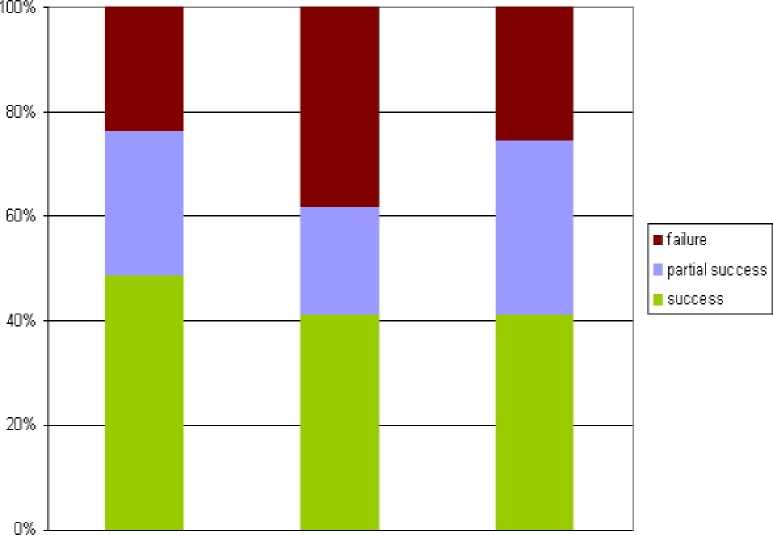Purerfellner H., Aichinger J., Martinek M., Nesser H.J., Janssen J, 10
“Short- and long-term experience in pulmonary vein segmental ostial ablation for
paroxysmal atrial fibrillation”
In most of the patients the LSPV (96%), LIPV (96%) and the RSPV (95%) were isolated
ostially, whereas the RIPV was targeted in only 55%. The reason for this is that this PV is
usually more difficult to reach and was spared in our early ablation experience from 2001 to the
first half of the year 2002. Consequently, the number of patients with PVI in 3PVs, 4 PVs or 2
PVs accounted for 40 % (n=47), 54% (n=63) and 6% (n=7), respectively.
Success rates
113 patients were evaluated for the determination of the clinical outcome after 6 months
(after 3 months only in 8/113 patients with a limited follow up). CRR accounted for 78% (88
patients) consisting of 52% CS (59 patients), 26% PS (29 patients) und 22% CF (25 patients),
respectively (Figure 2). CS was higher in patients undergoing PVI in 4 PVs versus PVI in 3 PVs
(54% versus 44%) (Figure 3). However, the CRR was similar in both groups (77% in 4 PVs and
78% in 3 PVs, respectively).
For the determination of the long term succes rate after a mean of 21±6 months only
those patients with PVI in 3 PVs (sparing the RIPV) were evaluated. For a total of 39 patients
the CS, PS and CF rates accounted for 41% (n=16), 21% (n=8), 38% (n=15), respectively,
leading to a CRR of 62% (n=24). Considering only this group of 39 patients for their specific
clinical course after 6 months separately, CS, PS and CF rates account for 41% (n=16), 33%
(n=13) and 26% (n=10), respectively, leading to a CRR of 74% (n=29) (Figure 2). From these
results one may conclude that CRR in the longterm follow up is reduced by a reduction in PS,
however, the CS rate seems stable even in the long run.
The clinical success rates per year of experience are depicted in Figure 4. As patients
had to have all procedures performed within a single year for this analysis, the number of
patients evaluated decreases to n=103.

6-month follow-up (n=105) Iatefollow-Up (n=39) 6-month Ofthosewith late
folow-uρ(n=39)
Figure 2: Success rates in the short- and longterm follow up period
Indian Pacing and Electrophysiology Journal (ISSN 0972-6292), 6(1): 6-16 (2006)
More intriguing information
1. Computing optimal sampling designs for two-stage studies2. The name is absent
3. Neighborhood Effects, Public Housing and Unemployment in France
4. The name is absent
5. On the Desirability of Taxing Charitable Contributions
6. FDI Implications of Recent European Court of Justice Decision on Corporation Tax Matters
7. Does Presenting Patients’ BMI Increase Documentation of Obesity?
8. The name is absent
9. European Integration: Some stylised facts
10. Non-farm businesses local economic integration level: the case of six Portuguese small and medium-sized Markettowns• - a sector approach